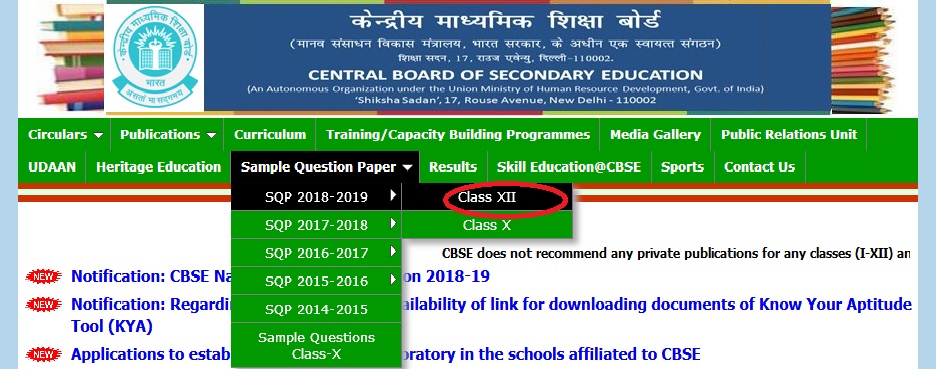CBSE Academic Class XII Engineering Graphics Sample Question Paper 2018-19 : cbseacademic.nic.in
Name of the Board : CBSE Academic
Class : XII STD
Document Type : Sample Question Paper
Subject : Engineering Graphics
Paper : Class XII Sample Question Paper 2018-19
Year : 2018-19
Website : http://cbseacademic.nic.in/SQP_CLASSXII_2018_19.html
CBSE Academic Class XII Engineering Graphics Question Paper
MM: 80
Time Allowed: 3 hours
Related : CBSE Academic Class XII Computer Science Sample Question Paper 2018-19 : www.pdfquestion.in/33472.html
General Instructions
(i) Attempt all the questions.
(ii) Use both sides of the drawing sheet, if necessary.
(iii) All dimensions are in millimetres.
(iv) Missing and mismatching dimensions, if any, may be suitably assumed.
(v) Follow the SP:46-2003 revised codes(with first angle method of projection).
(vi) In no view of question2, are hidden edges or lines required.
(vii) In question 4, hidden edges or lines are to be shown in views without section.
(viii) Number your answers according to questions.

Download Engineering Graphics Question Paper :
SQP :
https://www.pdfquestion.in/uploads/pdf2019/33483-EnggSQP.pdf
MS :
https://www.pdfquestion.in/uploads/pdf2019/33483-EnggMS.pdf
Section-A
1. Answer the following Multiple Choice questions. Print the correct choice on your drawing sheet. 5
(i) An inclined edge in isometric projection is drawn by
a) Using angle of inclination
b) Drawing a line at 900 to the vertical
c) Drawing a line at 300 to the horizontal
d) Using the co-ordinates
(ii) Which one of the following is used to join shaft and hub?
a) Gib
b) Key
c) Cotter
d) Rivet
(iii) The angle between the flanks of a BSW thread profile is
a) 550
b) 600
c) 300
d) 450
(iv) cut on the outer surface of a circular rod are called
a) The threads Crest thread
b) Root thread
c) Internal thread
d) External thread
(v) Which one of the following is represented by thin continuous lines?
a) Centre lines
b) Visible lines
c) Extension lines
d) Hidden lines
Section – B
2. (i) Construct an isometric scale. 4
(ii) An inverted frustum of a square pyramid (base edges 40mm and 50mm, height 35mm) is resting on H.P with two of its base edges perpendicular to V.P. Draw its isometric projection. Show the axis and indicate the direction of viewing. Give all the dimensions. 7
(ii) A sphere (diameter 70mm) is placed centrally on the top hexagonal face of a hexagonal prism (base edge 25mm, height 50mm). Two of the base edges of the prism are parallel to V.P. The common axis is perpendicular to H.P. Draw the isometric projection of the combination of solids. Show the common axis and indicate the direction of viewing. Give all the dimensions. 13
3. (i) Draw to scale 1:1, the standard profile of a Knuckle Thread, taking enlarged pitch as 50mm. Give standard dimensions. 8
OR
(i) Draw to scale 1:1, the front view and top view of a Square Headed Nut of diameter 30mm, keeping the axis vertical. Give standard dimensions.
(ii) Sketch freehand the front view and top view of a Pan Head Rivet of size M20, keeping the axis vertical. Give standard dimensions. 5
OR
(ii) Sketch freehand the front view and side view of a Collar Stud of size M20, keeping the axis horizontal. Give standard dimensions. 4.
Figure 1 shows the details of the parts of an SOCKET AND SPIGOT COTTER JOINT. Assemble these parts correctly, and then draw the following views using scale 1:1.
(i) Front view, upper half in section.
(ii) Left side view.
Print the title and the scale used. Draw the projection symbol. Give 6 important dimensions. 14 8 6
OR
Figure 2 shows the assembly of a BUSHED BEARING. Disassemble the parts and then draw the following views of the following components to scale 1:1, keeping their position same with respect to H.P. and V.P.
(i) BODY
a) Front view, left half in section.
b) Side view.
(ii) BUSH
a) Front view.
b) Side view in section
Print the titles and the scale used. Draw the projection symbol. Give 6 important dimensions.
Marking Scheme
Section-A :
1 Multiple choice questions
(i) d OR Using the co-ordinates 1
(ii) b OR Key 1
(iii) a OR 550 1
(iv) d OR External thread 1
(v) c OR Extension lines 1
2 (a) ISOMETRIC SCALE
(i) Marking of divisions of 10mm, including division of first part of 1mm on true length
(ii) Projections from scale 1:1 to get points on isometric scale, construction of isometric scale
(iii) Printing ‘True length / Scale 1:1’, Isometric length / Isometric scale’ and marking angles of 300 and 450 1 2 1
(b) ISOMETRIC PROJECTION OF A SPHERE, PLACED CENTRALLY ON A HEXAGONAL PRISM
(i) Drawing Isometric squares
(ii) Drawing slant edges
(iii) Drawing the axis and direction of viewing
(iv) Dimensions 3 2 1 1
(c) ISOMETRIC PROJECTION OF A SPHERE, PLACED CENTRALLY ON A HEXAGONAL PRISM SPHERE
(i) Locating the centre with isometric radius
(ii) Drawing the circle with true radius
(iii) Marking the vertical axis
(iv) Dimensions
HEXAGONAL PRISM
(i) Drawing helping figure
(ii) Drawing isometric hexagons
(iii) Drawing edges
(iv) Marking axis (?2) and direction of viewing (?2)
(v) Dimensions
3 (a) KNUCKLE THREAD PROFILE
(i) Distance, equal to pitch, marked correctly.
(ii) Semi-circular profile for threads (minimum two), drawn correctly
(iii) Dimensions and hatching lines
SQUARE NUT FRONT VIEW :
(i) Boundary lines with hidden lines showing threads with axis vertical and two opposite
edges parallel to V.P.
(ii) Drawing arc with radius R. TOP VIEW :
(i) Drawing three circles as per convention.
(ii) Square, circumscribing chamfer circle. Details : Dimensions.